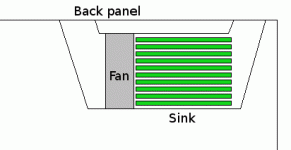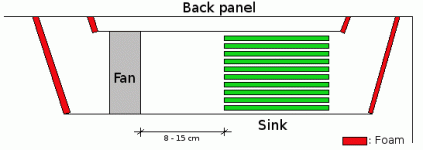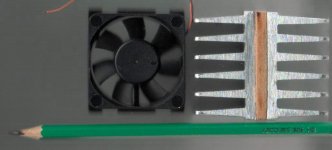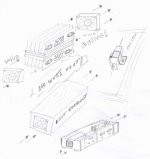Variable Fan Noise Control............
With some kind of thermal feedback circuit, you could control the fan speed to regulate the heatsink temperature.
I have heard comments from a manufacturer in the past about his amplifiers sounding best at a particular temperature - 55* C if I recall correctly, and he employed fan speed control for this purpose.
Variable fan speed control would allow slow speed and quiet at low audio output and high fan speed at high power output where fan noise would be less noticable.
Eric.
With some kind of thermal feedback circuit, you could control the fan speed to regulate the heatsink temperature.
I have heard comments from a manufacturer in the past about his amplifiers sounding best at a particular temperature - 55* C if I recall correctly, and he employed fan speed control for this purpose.
Variable fan speed control would allow slow speed and quiet at low audio output and high fan speed at high power output where fan noise would be less noticable.
Eric.
Circlotron said:To reduce the speed of an AC fan, IIRC AKSA suggested using a fluorescent tube ballast inductor in series.
I have used ceiling fan controllers for this purpose.
These controllers are a switch tapped inductor and allow variable speed control and are cheap.
Eric.
I experimented today with some cheap 100mm fans i had lying arround, and found a couple of old ones that (after cleaning and oiling) make *almost* no sound running at 9vdc, and move a good amount of air. So before opening your wallets, check your junk box or that old PSU you have as a doorstop!
Still trying to figure out how to fit a good surface area in a 100x100mm box without restraining airflow though.
Still trying to figure out how to fit a good surface area in a 100x100mm box without restraining airflow though.
Lisandro_P said:I experimented today with some cheap 100mm fans i had lying arround, and found a couple of old ones that (after cleaning and oiling) make *almost* no sound running at 9vdc, and move a good amount of air. So before opening your wallets, check your junk box or that old PSU you have as a doorstop!
Still trying to figure out how to fit a good surface area in a 100x100mm box without restraining airflow though.
I've got a very good idea on how to get the airflow through without causing dust to reach the internal components, on those typical die cast heatsinks you see being used on class a amplifiers..
Those Y.S.-Tech rim drive fans are probably quieter than most, but they are not silent. That 120mm fan you had was probably a lot quieter at that lower voltage, but most likely not truly "silent". I recommend you visit http://www.silentpcreview.com for information on some truly noiseless fans.
Circlotron said:
To reduce the speed of an AC fan, IIRC AKSA suggested using a fluorescent tube ballast inductor in series.
Exactly what is the difference between such a ballast inductor and a regular inductor? And, assuming conventional inductors can be used for this purpose, how does one find suitable values for them?
Attached here is a rough sketch of the design i'm contemplating right now. The "tube" is made of tin or other thin metal, with the top removable, and the fan is held vertical by two L-shaped flanges. What i'm working on now is how to keep the damn dust out.
Attachments
Lisandro,
You might find that the turbulence induced by the rapid rotation of the vanes right near the fins of the heatsink creates quite a bit of noise.
The solution,I have found, is to use a 10-15 cms long plenum chamber, whose purpose is to make the airstream more laminar before it enters the sink. This will also help with dust formation too, which is usually prevented by putting a filter on the induction side of the fan.
I'm doing a Class A at present using this precise technique.
In response to the question on inductors to slow the fan, I note that fluro ballasts are dirt cheap and rated for mains operation. This is in sharp contrast with purpose built inductors!
Cheers,
Hugh
You might find that the turbulence induced by the rapid rotation of the vanes right near the fins of the heatsink creates quite a bit of noise.
The solution,I have found, is to use a 10-15 cms long plenum chamber, whose purpose is to make the airstream more laminar before it enters the sink. This will also help with dust formation too, which is usually prevented by putting a filter on the induction side of the fan.
I'm doing a Class A at present using this precise technique.
In response to the question on inductors to slow the fan, I note that fluro ballasts are dirt cheap and rated for mains operation. This is in sharp contrast with purpose built inductors!
Cheers,
Hugh
After taking both advices in consideration (thanks!), i redrew the design. I originally didn't intend to keep the tube ends so tight to the fan / sink, but in spite of keeping the image small i drew it like that. The new sketch is much more what i originally had in mind.
gmphadte, i thought of placing the tube vertical but my amp will be sitting in an horizontal chasis, so it's really not an option
What i didn't thought about was noise because of air hitting the sink flanges. So i'll move, as Hugh suggested, the fan away from the sink itself. I also added the foam covering on the air entrance & exit; which can help, to some degree, in reducing noise.
A point i haven't touched is that if you add a fan, you must monitor it in some way. Rod Elliot has a pretty nice design for temperaute monitoring; mine will be integrated in the remote power-on board and will shut down the amp if the sink exceeds a preset temperature.
gmphadte, i thought of placing the tube vertical but my amp will be sitting in an horizontal chasis, so it's really not an option
What i didn't thought about was noise because of air hitting the sink flanges. So i'll move, as Hugh suggested, the fan away from the sink itself. I also added the foam covering on the air entrance & exit; which can help, to some degree, in reducing noise.
A point i haven't touched is that if you add a fan, you must monitor it in some way. Rod Elliot has a pretty nice design for temperaute monitoring; mine will be integrated in the remote power-on board and will shut down the amp if the sink exceeds a preset temperature.
Attachments
Lizandro, that curve made by Rodd, makes the air turn.
Create a lot of turbulence.... this is a problem to the air flow, alike some resistance.
Take a look in our forum, since its beggining, you will see very good ideas related that.
This one is reasonable too.
Carlos
Create a lot of turbulence.... this is a problem to the air flow, alike some resistance.
Take a look in our forum, since its beggining, you will see very good ideas related that.
This one is reasonable too.
Carlos
Attachments
I used tunnel type heatsinks, with speed regulated fan. I planned the regulating circuit by myself. It keep the fan running with low speed, if the temperature is low, and speed up, if the temperature rising. This circuit is very sensitive, if You put Your hands between the fan and the hetasink it speed up within one second....
I found the followings:
- use the shortest route for the air. This keeps the cooling very effective
- use the fan with the lowest possible speed. This keeps the noise low.
- keep the air inside the heatsink
- the inlet, and the outlet must be far away from each other
sajti
I found the followings:
- use the shortest route for the air. This keeps the cooling very effective
- use the fan with the lowest possible speed. This keeps the noise low.
- keep the air inside the heatsink
- the inlet, and the outlet must be far away from each other
sajti
Make the 90 degrees angles a rounded corner
The best you can round the corners, the lesser the noise you will have....use straight line, as the main direction to wind flow.... assemble fan over flexible rubber.
Fan is fun!
Reduce space
Increase heatsinking
Can make things pretty too, depends on you.
Turns and absortion panels are made to reduce noise...so, better than reduce the damn noise, is not to produce this noise.
If noise fan must be used, small heatsinks used, or needing to push the maximum fan speed, you will need to make turns to absorb the noise, those curves will reduce wind speed, together with the noise reduction, efficiency will decrease.....not a good idea, spiral, curved ducts or things alike.
Push air from your front panel to back or oposite direction, also you can make the hole amplifier a tunel, this way, rectifier diodes and transformers will be cooled too....but the dirty inside will be terrible.
regards,
Carlos
regards,
Carlos
The best you can round the corners, the lesser the noise you will have....use straight line, as the main direction to wind flow.... assemble fan over flexible rubber.
Fan is fun!
Reduce space
Increase heatsinking
Can make things pretty too, depends on you.
Turns and absortion panels are made to reduce noise...so, better than reduce the damn noise, is not to produce this noise.
If noise fan must be used, small heatsinks used, or needing to push the maximum fan speed, you will need to make turns to absorb the noise, those curves will reduce wind speed, together with the noise reduction, efficiency will decrease.....not a good idea, spiral, curved ducts or things alike.
Push air from your front panel to back or oposite direction, also you can make the hole amplifier a tunel, this way, rectifier diodes and transformers will be cooled too....but the dirty inside will be terrible.
regards,
Carlos
regards,
Carlos
I would use the tunnel with air intake at the rear panel. Put the fan to the rear panel as well. The outlet could anywhere, and if the heatsink tunnel ending inside the box, and use lot of small holes on the box will reduce the noise too. Direct out on the front panel will be noisy.
If anybody interesting, I will put my schematic for the temperature controlled fan speed.
sajti
If anybody interesting, I will put my schematic for the temperature controlled fan speed.
sajti
Lisandro_P said:Is that a good idea? You're efectively heating the inside of the case that way, increasing the ambient temperature for the sinks - which makes them run hotter.
The heatsink gets the air from the intake, so there is no higher temperature for the heatsinks. You have right, it can increase the temperature inside the case. But carefully designed holes the difference is not too high.
Another solution can be to get the air from the case, and exhaust on the rear. This solution also reduce the noise (fan inside the box), but sometimes it can increase the temperature of the heatsinks due the higher temperature of the inside air...
sajti
- Status
- This old topic is closed. If you want to reopen this topic, contact a moderator using the "Report Post" button.
- Home
- Amplifiers
- Solid State
- A better fan design - the search continues



